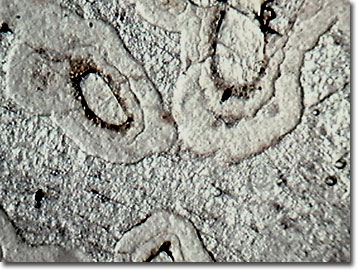Oblique Digital Image Gallery
Jurassic Dinosaur Bone
There is no need to travel to Jurassic Park or the geologic past to observe dinosaur bones under a microscope. Fossilized dinosaur bones, first discovered in Europe in the 1820s, have since been unearthed on all of the continents. The structure of the organic bone matrix is preserved, most often in sedimentary rock, through mineralization of the bone on the microscopic scale by quartz crystals and other replacement compounds of silica, calcite, dolomites, carbonates, and iron.

View a second image of a Jurassic dinosaur bone.
In the Mesozoic Era (248 to 65 millions years ago), the dinosaurs blossomed, but also during the same period the first mammals, birds, and flowering plants made their debuts. Even earlier, in the Jurassic Period, from 206 to 144 million years ago, dinosaurs dominated and radiated into many species and the first birds appeared on Earth. By the mid-Jurassic period, the supercontinent Pangea started to drift apart, leading to dinosaur speciation due to isolation, coupled with environmental changes and competition. The Age of Dinosaurs came to a crashing finale by the Late Cretaceous Period (89-65 million years ago) with a mass extinction event that has recently been coupled to a meteorite impact near Cancun, Mexico. During these two hundred million years or so, dinosaurs lived and died, with some of the remains settling into sediments, beginning the fossil formation process.
Many of the fossilized dinosaur bones found from Jurassic geological deposits contain clues to the morphology, behavior, and ecology of some of the more familiar dinosaur species such as the flying Archaeopteryx, the oceanic Stenoterygius, the huge vegetarian Branchiosaurus, and the "terrible" high-level carnivore, Ceratosaurus. However, the fossil record is far from complete because conditions favoring fossilization did not always occur in areas where dinosaurs perished. Whether or not a fossil is formed by the remains of a dead dinosaur depends on climatic and geologic conditions, and location of the death and deposition of the body or parts. However, just because a fossil formed properly, does not mean that paleontologists have already located and fully described it. Every year, paleontologists discover new fossil deposits, make new scientific descriptions, and formulate new inferences of the Earth's past climatic conditions and the lives of the "thunder lizards."
Contributing Authors
Cynthia D. Kelly, Thomas J. Fellers and Michael W. Davidson - National High Magnetic Field Laboratory, 1800 East Paul Dirac Dr., The Florida State University, Tallahassee, Florida, 32310.
BACK TO THE OBLIQUE IMAGE GALLERY
BACK TO THE DIGITAL IMAGE GALLERIES
Questions or comments? Send us an email.
© 1995-2025 by Michael W. Davidson and The Florida State University. All Rights Reserved. No images, graphics, software, scripts, or applets may be reproduced or used in any manner without permission from the copyright holders. Use of this website means you agree to all of the Legal Terms and Conditions set forth by the owners.
This website is maintained by our
Graphics & Web Programming Team
in collaboration with Optical Microscopy at the
National High Magnetic Field Laboratory.
Last Modification Friday, Nov 13, 2015 at 01:19 PM
Access Count Since September 17, 2002: 8455
Visit the website of our partner in introductory microscopy education:
|
|
